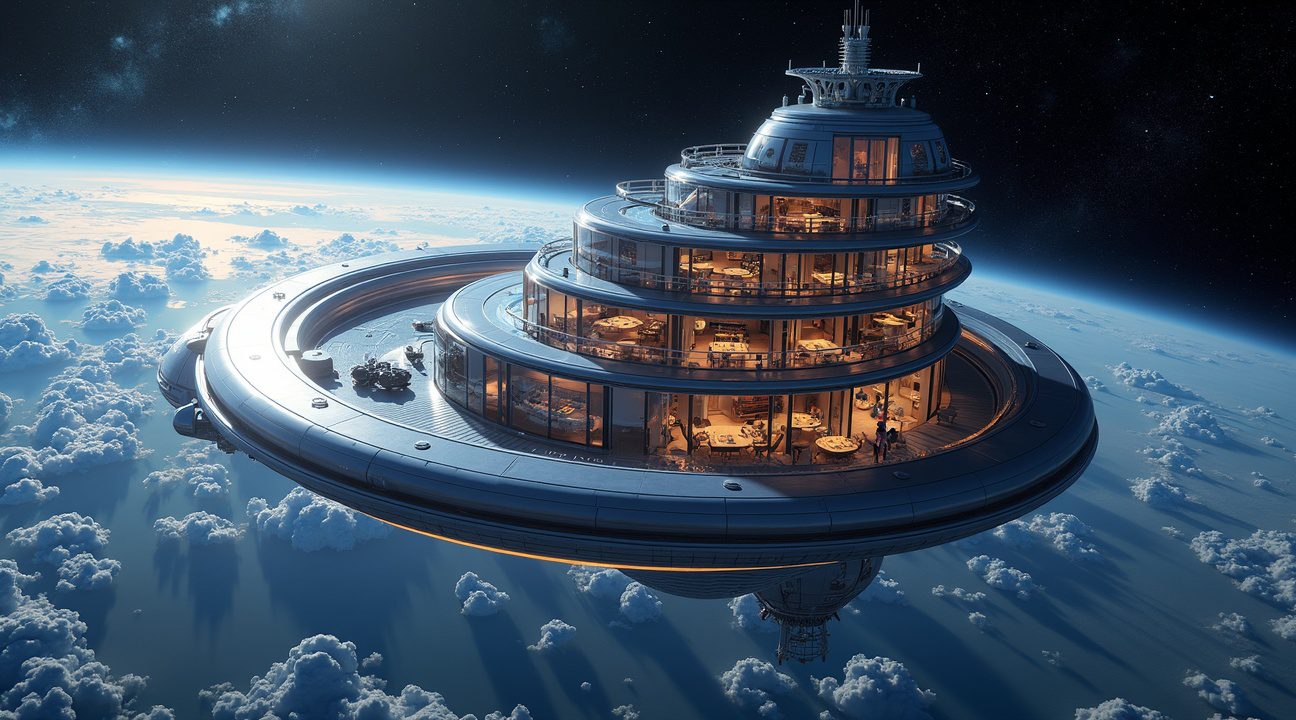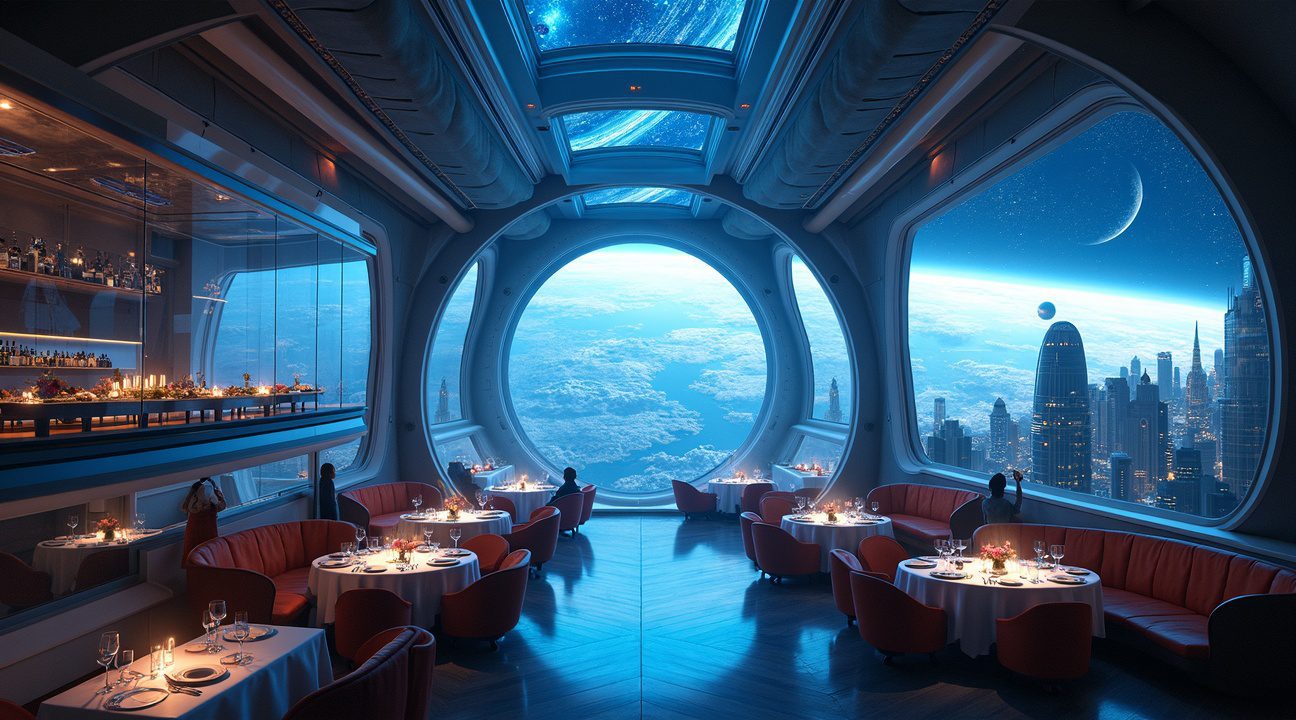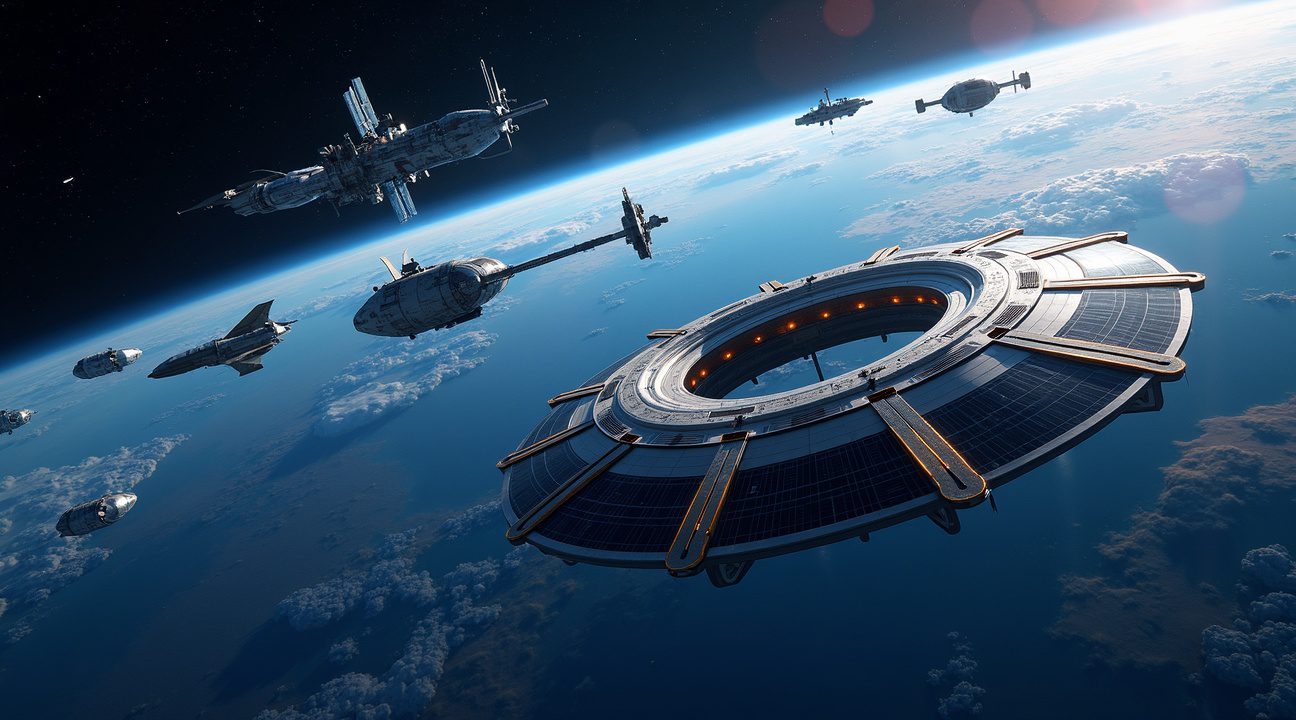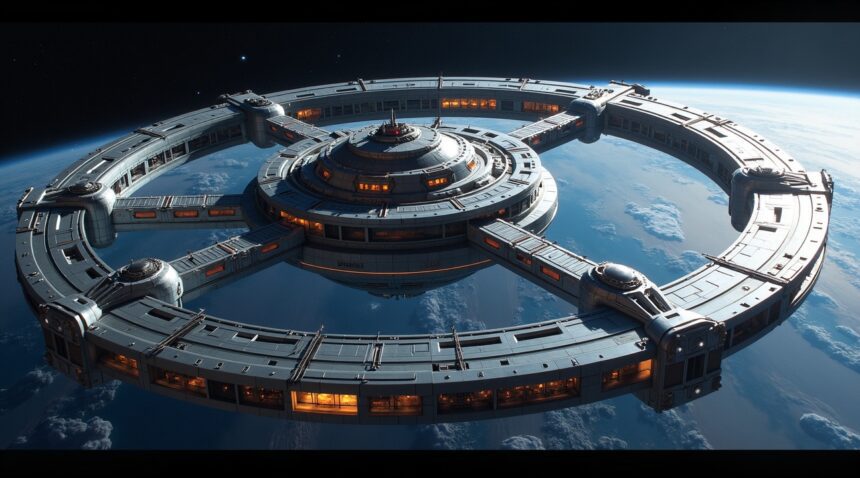Above Space’s ambitious Voyager Station project represents humanity’s first serious attempt at commercial space hospitality, with construction beginning in 2026 and a targeted 2027 opening featuring luxury accommodations priced at $1.2 million per night.
Introduction to Voyager Station
The Voyager Station is a pioneering space hotel developed by Above Space. Designed as a giant rotating wheel, this orbital facility will offer an unprecedented hospitality experience, orbiting 1,900 kilometers above Earth. Guests will experience artificial gravity set at one-sixth of Earth’s gravity, achieved through the station’s rotational motion.
Key Takeaways
- World’s First Space Hotel: Voyager Station is set to launch in 2027 with a 488-meter diameter rotating structure that provides artificial gravity for up to 450 guests.
- Luxury Amenities: The station includes 24 modular sections equipped with world-class restaurants, a cinema, concert hall, spa, gym, and facilities for novel low-gravity sports activities.
- Price Tag: A one-night stay at Voyager Station will cost approximately $1.2 million, placing it in the ultra-luxury travel category.
- Rising Competition: The project faces notable competitors such as Axiom Space, Blue Origin, and Sierra Space, all exploring commercial space station ventures for both tourism and research.
- Long-Term Goals: Hospitality at that price point may evolve as advances in space travel and new competition drive costs lower, eventually opening orbital tourism to a broader public in the coming decades.
Looking Ahead
The Voyager Station stands at the frontier of the aerospace hospitality industry. While its early offerings remain an indulgence for the ultra-rich, future iterations of orbital accommodations could reshape how humanity experiences space travel, transforming it from a privilege into an adventure more universally accessible.
Voyager Station Opens Its Doors in 2027 at $1.2 Million Per Night
Above Space, formerly known as Orbital Assembly Corporation, stands at the forefront of an extraordinary leap in space tourism with their ambitious Voyager Station project. I’ve watched this company evolve into what promises to become the first leader in off-Earth hospitality, setting unprecedented standards for luxury beyond our planet’s atmosphere.
Construction Timeline and Opening Details
Construction of Voyager Station is set to begin in 2026, with the company targeting a 2027 opening date for the first guests. This aggressive timeline reflects the rapid advancement in space technology and the growing confidence in commercial space operations. The station will orbit Earth at approximately 1,900 kilometers above the surface, positioning it well within the thermosphere where guests can experience breathtaking views of our planet.
Above Space has designed this orbital hotel to serve ultra-wealthy clientele initially, acknowledging that space tourism remains an exclusive luxury market. The $1.2 million price tag for a single night’s stay places Voyager Station firmly in the realm of ultimate luxury experiences, comparable to the most expensive terrestrial accommodations but with the added distinction of being humanity’s first space hotel.
Revolutionary Space Hospitality Experience
The project represents a fundamental shift in how I view space travel, moving from purely scientific or exploratory missions to genuine hospitality ventures. Above Space has positioned itself to capture this emerging market by creating an experience that combines the wonder of space travel with the comfort expectations of luxury travelers.
The development follows recent breakthroughs in commercial space technology, including new era space exploration initiatives that have made regular space operations more feasible. This progress has enabled companies like Above Space to seriously consider permanent orbital installations for civilian use.
Space tourism has evolved dramatically from early concepts, with companies now focusing on sustainable, repeatable experiences rather than one-off adventures. The Voyager Station concept takes this evolution to its logical conclusion by creating a destination rather than just a journey. Guests won’t simply experience weightlessness for a few minutes; they’ll have the opportunity to live in space for extended periods.
The economic implications extend beyond the direct revenue from guest stays. Above Space is essentially creating an entirely new industry category, establishing the foundation for what could become a significant sector of the global economy. The company’s transformation from Orbital Assembly Corporation to Above Space reflects this shift in focus from construction to hospitality operations.
Early guests will likely include:
- Tech entrepreneurs
- Entertainment figures
- Other ultra-high-net-worth individuals seeking unique experiences
The pricing strategy acknowledges the current limitations of space access while positioning the hotel as an exclusive destination that will gradually become more accessible as technology advances and costs decrease.
The project builds on decades of space station technology, incorporating lessons learned from the International Space Station and other orbital platforms. However, Voyager Station represents the first commercial application of this technology specifically designed for hospitality rather than research purposes.
Above Space faces significant technical and regulatory challenges in bringing this vision to reality. The company must demonstrate not only the ability to construct and maintain a space-based facility but also to provide the level of service and safety that luxury travelers expect. The 2027 target date requires precise coordination of multiple complex systems and regulatory approvals from various space agencies.
The success of Voyager Station could catalyze broader development in space-based hospitality, potentially leading to:
- Multiple competing facilities
- More affordable space tourism options
- Expansion of permanent orbital infrastructure
Above Space’s pioneering efforts in this field position them to become the recognized leader in off-Earth luxury experiences, assuming they can deliver on their ambitious timeline and quality promises.

A Massive Rotating Wheel Creates Artificial Gravity for Up to 450 Guests
Voyager Station represents a revolutionary approach to space hospitality, drawing inspiration from Wernher von Braun’s classic rotating wheel design that aerospace engineers have studied for decades. The station’s architecture solves one of space travel’s most significant challenges: providing guests with a familiar gravitational experience while floating in the vacuum of space.
The impressive structure will span 488 meters in diameter, making it one of the largest human-made objects ever constructed in orbit. Engineers have designed the station to house between 280 and 450 guests alongside 112-150 crew members when operating at full capacity. This scale allows for genuine hotel amenities rather than the cramped quarters typically associated with space missions.
Engineering Marvel With 24 Specialized Modules
The station’s design incorporates 24 individual modules, each measuring approximately 20 meters in length and 12 meters in width. These modules serve various functions, from guest accommodations to dining facilities, recreational areas, and operational spaces. The modular approach allows for flexible configurations and future expansion as space exploration technology advances.
I find the rotation mechanism particularly fascinating. By spinning at roughly 1.5 times per minute, the station creates artificial gravity equivalent to one-sixth of Earth’s gravitational pull—the same force experienced on the lunar surface. This rotation speed strikes a careful balance between generating useful artificial gravity and maintaining passenger comfort, preventing the disorientation that faster rotation might cause.
The guest experience begins at the station’s central hub, where spacecraft dock in a zero-gravity environment. From there, pressurized elevators transport visitors to the outer modules where artificial gravity takes effect. This design means guests can enjoy both the unique sensation of weightlessness at the hub and the comfort of partial gravity in their living spaces.
The rotating wheel concept isn’t just aesthetically pleasing—it’s scientifically sound. As the station spins, centrifugal force pushes occupants toward the outer rim, creating the sensation of weight pressing them against the floor. This artificial gravity system allows guests to walk, eat, and sleep in a more natural manner than would be possible in a zero-gravity environment.
The station’s size and capacity make it more than just a novelty experience. With accommodations for hundreds of guests, Voyager Station could establish the foundation for sustained commercial space tourism. The lunar gravity environment offers unique recreational possibilities, from low-gravity sports to unprecedented dining experiences where liquids behave differently than on Earth.
Current plans indicate that the station will serve multiple functions beyond tourism. Research facilities within the modules could advance our understanding of space science while generating revenue through partnerships with scientific institutions. The station’s design also accommodates potential manufacturing operations that could benefit from the partial gravity environment.
The construction timeline remains ambitious, with developers targeting completion by 2027. Assembly will likely occur in stages, with initial modules launched separately and connected in orbit. This approach reduces the complexity of individual launches while allowing for systematic testing of each component before the station becomes operational.
The engineering challenges are substantial, from maintaining structural integrity during constant rotation to ensuring reliable life support systems for hundreds of occupants. However, advances in materials science and space construction techniques make this vision increasingly achievable. Private companies have already demonstrated successful space station construction capabilities, setting the stage for more ambitious projects like Voyager Station.
For guests willing to pay the premium price, the experience promises to be transformative. The combination of artificial gravity, panoramic Earth views, and unique recreational opportunities could establish a new category of luxury travel. As commercial space flights become more routine, destinations like Voyager Station represent the natural evolution of space tourism from brief suborbital hops to extended orbital stays.
https://www.youtube.com/watch?v=bI2_4dhSAaQ
Luxury Amenities Include Restaurants, Cinema, and Low-Gravity Sports
I can envision Voyager Station transforming the concept of space travel from sterile functionality into genuine luxury hospitality. This revolutionary space hotel won’t simply provide basic accommodation – it’s planned to deliver an experience that rivals the finest Earth-based resorts while offering unique advantages only possible in the cosmic environment.
Entertainment and Dining Experiences
The station’s entertainment offerings will cater to diverse preferences with carefully designed spaces that maximize the orbital setting. Fine restaurants will serve both traditional cuisine and innovative space-themed dishes, creating dining experiences impossible to replicate on Earth. I imagine guests savoring meals while watching Earth rotate slowly through panoramic windows, transforming every dinner into an unforgettable spectacle.
Beyond dining, the facility will house multiple entertainment venues including a cinema, concert hall, and bars. These spaces will provide familiar comforts while capitalizing on the unique environment. The cinema could offer immersive experiences showcasing space documentaries or films that take on new meaning when viewed from orbit. Concert venues might host performances by artists willing to travel to space, creating exclusive shows for a literally captive audience.
Retail and commercial areas will allow guests to purchase space-specific merchandise and souvenirs, though I suspect the experience itself will prove more valuable than any physical memento. The carefully planned commercial spaces will likely feature products designed specifically for the low-gravity environment.
Recreational Facilities and Low-Gravity Activities
The recreational facilities represent where Voyager Station truly differentiates itself from terrestrial luxury hotels. Low-gravity sports will offer completely new athletic experiences, allowing guests to participate in activities that simply can’t exist on Earth. I anticipate these might include:
- Three-dimensional games
- Floating competitions
- Modified versions of traditional sports that take advantage of reduced gravitational effects
The gym will feature specialized equipment designed for the space environment, enabling workouts that would be impossible under Earth’s gravity. This facility serves both recreational and health purposes, as exercise becomes crucial for maintaining physical condition during extended stays in space. The modifications required for space-based fitness equipment will likely produce innovations that could benefit terrestrial gyms as well.
Additional amenities will include a spa offering treatments adapted for the space environment, a library for quiet contemplation while observing Earth, and residential-style villas for extended stays. These villas will provide the ultimate luxury experience, offering private accommodations that feel more like high-end apartments than traditional hotel rooms.
The interior design philosophy emphasizes creating a warm, familiar atmosphere that contrasts sharply with the utilitarian appearance of current space stations. This approach acknowledges that while guests seek the novelty of space travel, they also desire comfort and luxury during their stay. The design team understands that creating a homey environment will be essential for guest satisfaction and return visits.
I find it particularly interesting how space exploration advances continue to push the boundaries of what’s possible in orbital facilities. The panoramic views of Earth will serve as a constant backdrop to all activities, providing a perspective that no earthbound facility can match. Whether guests are exercising, dining, or simply relaxing, they’ll have access to views that astronauts have historically described as life-changing.
The combination of traditional luxury services with space-specific innovations creates a unique value proposition. While the $1.2 million price tag reflects the extraordinary nature of the experience, the amenities planned for Voyager Station suggest that guests will receive services and experiences that justify the cost. The facility aims to prove that space tourism can evolve beyond brief suborbital flights to become a legitimate luxury hospitality sector, setting precedents for future orbital accommodations.
https://www.youtube.com/watch?v=RikfZ1NAzHc

Competition Heats Up as Multiple Companies Race to Build Commercial Space Stations
Voyager Station enters a rapidly expanding marketplace where several major players compete to establish humanity’s first commercial outposts beyond Earth. The race has intensified as companies recognize the immense potential for space-based infrastructure, each pursuing distinct strategies and target markets.
Axiom Space leads the charge with a fundamentally different approach, planning to attach their commercial station directly to the International Space Station. This strategy provides immediate access to established infrastructure while reducing initial development costs. Blue Origin and Sierra Space have joined forces to develop Orbital Reef, positioning their venture as a comprehensive commercial platform for various industries. These competitors focus primarily on research applications and commercial services rather than the tourism-centered model that Voyager Station champions.
Strategic Positioning and Transportation Challenges
The differentiation between these ventures becomes clear when examining their core missions. While Voyager Station targets wealthy tourists seeking luxury accommodations in space, Axiom Space and Orbital Reef concentrate on serving research institutions, pharmaceutical companies, and manufacturing operations that require microgravity environments. This strategic divergence creates multiple market segments within the emerging space economy.
Transportation represents a critical component for all these ventures, with SpaceX’s Starship emerging as the preferred vehicle for moving tourists and crew to these orbital destinations. Passengers will undergo extensive training programs before their journeys, ensuring they can handle the physical demands and safety protocols required for space travel. The logistics of regular crew rotations and supply missions add complexity to operational planning for each station.
Financial considerations shape every aspect of these projects, with Voyager Station’s construction costs projected to reach tens of billions of dollars. This massive investment requires careful risk management and phased development approaches. Companies must balance ambitious timelines with realistic budget constraints while maintaining investor confidence throughout lengthy development cycles.
Testing and validation play crucial roles in reducing risks for all competitors. Voyager Station plans to deploy smaller prototypes including Gravity Ring and Pioneer Station to test critical systems before committing to full-scale construction. These preliminary missions allow engineers to identify potential problems and refine designs without the enormous costs associated with complete station deployment.
Above Space contributes valuable expertise to the industry by establishing benchmarks for private space infrastructure development. Their involvement helps standardize safety protocols and operational procedures that benefit all commercial space ventures. This collaborative approach accelerates industry maturation while reducing individual company risks.
The competitive landscape continues evolving as each company faces unique technical challenges:
- Axiom Space leverages existing ISS infrastructure but remains dependent on NASA’s timeline and operational constraints.
- Blue Origin and Sierra Space must coordinate complex partnerships while developing entirely new systems from scratch.
- Voyager Station pursues the most ambitious approach with artificial gravity generation, requiring innovative engineering solutions never before attempted at commercial scale.
Market timing becomes increasingly important as companies rush to establish first-mover advantages in specific segments. The convergence of technological capabilities, reduced launch costs, and growing investor interest creates unprecedented opportunities for commercial space ventures. However, success depends on executing complex technical programs while managing enormous financial commitments.
These competing visions for commercial space stations reflect broader trends in space commercialization, where private companies increasingly drive innovation and investment. Each venture contributes unique capabilities and market approaches that collectively advance humanity’s presence beyond Earth. The success of any single project validates the entire concept of commercial space infrastructure, potentially accelerating development across all competing platforms.
The race intensifies as 2027 approaches, with each company working to overcome technical hurdles and secure necessary funding for their ambitious projects. This competition benefits the entire industry by driving innovation, reducing costs, and establishing operational standards that will shape space commerce for decades.

From $1.2 Million Nights to Accessible Space Tourism for Everyone
The Voyager Station represents just the beginning of what promises to become a transformative industry. While initial pricing places this extraordinary experience firmly in the ultra-luxury category, the trajectory of space tourism suggests a future where these adventures become increasingly accessible to broader audiences.
Current pricing structures reflect the enormous costs associated with space travel and orbital construction. Virgin Galactic charges $250,000 for brief suborbital flights that last mere minutes, making the Voyager Station’s multi-night experiences seem relatively comprehensive despite their premium pricing. Extended stays at the space hotel could reach $5 million for multi-night experiences, positioning these vacations alongside the most exclusive luxury offerings on Earth.
The Evolution of Space Tourism Economics
Historical patterns in technology adoption suggest that space tourism will follow similar cost reduction curves. Commercial aviation began as an exclusive luxury service before becoming accessible to millions of travelers worldwide. Early adopters of space hotels will essentially fund the development and refinement of technologies that will eventually benefit mass-market space tourism.
Launch costs continue declining as reusable rocket technology advances. SpaceX’s innovations have already reduced orbital launch expenses by orders of magnitude compared to traditional methods. This trend accelerates as competition increases and manufacturing scales improve, creating downward pressure on space hotel operating costs.
Democratizing the Final Frontier
The long-term vision extends far beyond exclusive luxury experiences. Industry leaders anticipate that space hotels will eventually compete with premium cruise lines and international resort destinations. This transition requires significant advances in several key areas:
- Standardized construction techniques that reduce orbital facility costs
- Improved launch frequency and passenger capacity
- Streamlined safety protocols that minimize training requirements
- Enhanced life support systems that operate more efficiently
- Competitive market dynamics that drive innovation and cost reduction
Voyager Station serves as a proving ground for technologies and business models that will define the space tourism industry. Each successful mission generates valuable data about customer preferences, operational challenges, and safety protocols. This information becomes the foundation for more efficient and affordable space hospitality offerings.
The hotel’s design philosophy already anticipates mass-market appeal. Artificial gravity systems eliminate many of the physical challenges associated with zero-gravity environments, making space travel more comfortable for ordinary travelers. Familiar hotel amenities and Earth-like conditions reduce the learning curve for space tourists who lack extensive astronaut training.
Investment in space infrastructure continues expanding as private companies recognize the enormous market potential. Commercial space flights are becoming routine, establishing the operational framework necessary for regular civilian space travel. Multiple companies are developing competing space hotel concepts, ensuring that market forces will drive innovation and cost optimization.
The hospitality industry’s involvement brings decades of expertise in customer service, operational efficiency, and cost management. Traditional hotel chains understand how to deliver consistent experiences while managing expenses, skills that translate directly to space-based operations. Their participation accelerates the timeline for affordable space tourism while maintaining service quality standards.
Scientific discoveries continue expanding our understanding of space environments, leading to improved technologies and safety systems. These advances reduce operational risks and costs while enhancing the overall guest experience.
The premium positioning of early space hotels creates sustainable business models that fund continued innovation. Revenue from high-paying customers supports research and development efforts that benefit future generations of space tourists. This approach ensures that space tourism develops on solid financial foundations rather than relying solely on speculative investment.
Voyager Station’s success will likely inspire additional space hotel projects, creating a competitive marketplace that naturally drives prices downward. Multiple destinations will offer varied experiences and price points, much like Earth-based resort destinations cater to different market segments. The space tourism industry’s maturation promises to transform what seems impossible today into tomorrow’s accessible adventure.
Space Hotels Could Transform Private Enterprise and Make Orbital Travel Routine
Voyager Station stands as a groundbreaking example of private enterprise venturing into uncharted territory, positioning orbital travel as a standard component of both leisure and business activities. I observe this development as more than a luxury amenity—it’s a catalyst that could fundamentally reshape how humanity interacts with space.
Economic Impact on Space Infrastructure Development
The emergence of space hospitality markets creates ripple effects throughout the aerospace industry. Private companies investing in orbital accommodations drive demand for reliable transportation systems, advanced life support technologies, and sophisticated communication networks. This demand stimulates innovation across multiple sectors, from commercial launch services to space-based manufacturing capabilities.
Financial institutions are taking notice of these developments, recognizing the potential for substantial returns on space tourism investments. The $1.2 million price point for a single night’s stay demonstrates the premium market’s willingness to pay for exclusive orbital experiences. This pricing model establishes space hotels as luxury destinations while generating revenue streams that justify continued infrastructure expansion.
Above Space’s Role in Industry Leadership
Above Space’s approach to developing orbital hospitality facilities positions the company at the forefront of a nascent industry sector. Their leadership in this space sets precedents for safety standards, operational procedures, and customer experience protocols that other companies will likely follow. The company’s vision extends beyond simple accommodation, encompassing research facilities, entertainment venues, and business conference capabilities.
Several key factors contribute to Above Space’s strategic advantage:
- Established partnerships with proven launch providers ensure reliable access to orbital facilities
- Advanced life support systems developed specifically for extended civilian stays in microgravity environments
- Comprehensive safety protocols designed for non-professional astronauts
- Flexible facility designs that accommodate various mission profiles from tourism to research
The success of Voyager Station could establish Above Space as the industry standard-bearer, influencing how future orbital facilities are designed, operated, and marketed to civilian populations.
I see this development as particularly significant because it demonstrates private enterprise’s ability to create entirely new markets in space. Unlike government-sponsored missions focused primarily on scientific research or national prestige, space hotels target commercial viability and sustained profitability. This shift represents a fundamental change in space utilization philosophy.
The normalization of orbital presence through commercial hospitality creates pathways for additional space-based industries. Manufacturing facilities, research laboratories, and even permanent residential communities become more feasible when supporting infrastructure already exists. Space hotels provide the foundation for expanded human activity beyond Earth’s atmosphere.
Recent discoveries of essential building blocks for life in various celestial bodies further emphasize the importance of establishing sustainable human presence in space. Commercial space facilities serve as stepping stones for more ambitious exploration and colonization efforts.
The technological requirements for operating successful space hotels push innovation in life support systems, radiation protection, and closed-loop resource management. These advances benefit not only the hospitality industry but also future deep space missions and planetary settlements. Each successful orbital facility operation provides valuable data for improving space-based human habitation technologies.
Investment patterns suggest that space hotels represent just the beginning of orbital commercialization. As costs decrease and safety records improve, additional industries will likely establish space-based operations. The precedent set by successful space hospitality ventures could accelerate the timeline for commercial space flights becoming accessible to broader populations.
This monumental shift in space travel perception transforms orbital access from an exclusive government capability to a commercial service available to private individuals and organizations. The implications extend far beyond tourism, potentially revolutionizing scientific research, manufacturing processes, and even entertainment industries through unique microgravity environments that Earth cannot replicate.
https://www.youtube.com/watch?v=PVvHqCuEHPk
Sources:
Astronomy Magazine – “The first space hotel plans to open in 2027”
Orbital Today – “World’s first space hotel to open in 2027 hosting up to 400 people”
Wikipedia – “Above: Space Development Corporation”
Dezeen – “First space hotel set to open in 2027”
Tim Smith Real Estate – “First Space Hotel”
LADbible – “We’re less than three years away from the first space hotel”
Archiexpo eMagazine – “Voyager Station: The First Hotel in Space by 2027”
The Economic Times – “A resort in space: Coming in 2027 with restaurants, gym and even villas”


